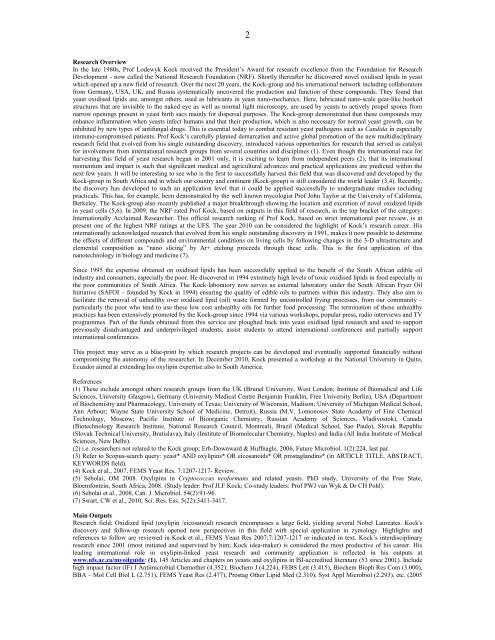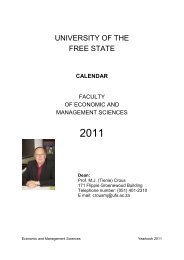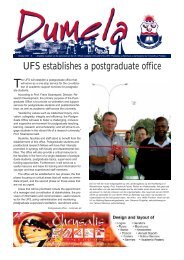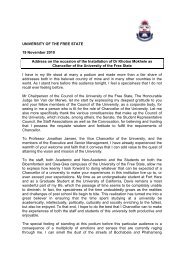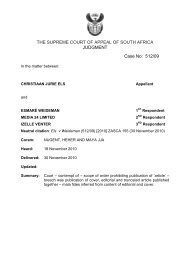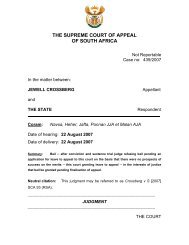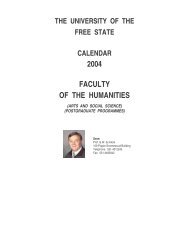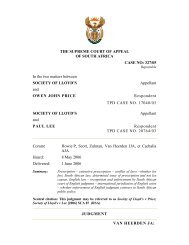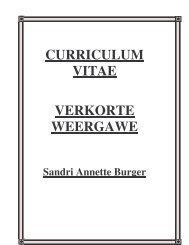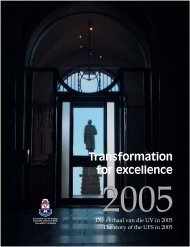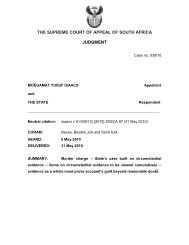View - University of the Free State
View - University of the Free State
View - University of the Free State
- No tags were found...
You also want an ePaper? Increase the reach of your titles
YUMPU automatically turns print PDFs into web optimized ePapers that Google loves.
2Research OverviewIn <strong>the</strong> late 1980s, Pr<strong>of</strong> Lodewyk Kock received <strong>the</strong> President’s Award for research excellence from <strong>the</strong> Foundation for ResearchDevelopment - now called <strong>the</strong> National Research Foundation (NRF). Shortly <strong>the</strong>reafter he discovered novel oxidised lipids in yeastwhich opened up a new field <strong>of</strong> research. Over <strong>the</strong> next 20 years, <strong>the</strong> Kock-group and his international network including collaboratorsfrom Germany, USA, UK, and Russia systematically uncovered <strong>the</strong> production and function <strong>of</strong> <strong>the</strong>se compounds. They found thatyeast oxidised lipids are, amongst o<strong>the</strong>rs, used as lubricants in yeast nano-mechanics. Here, lubricated nano-scale gear-like hookedstructures that are invisible to <strong>the</strong> naked eye as well as normal light microscopy, are used by yeasts to actively propel spores fromnarrow openings present in yeast birth sacs mainly for dispersal purposes. The Kock-group demonstrated that <strong>the</strong>se compounds mayenhance inflammation when yeasts infect humans and that <strong>the</strong>ir production, which is also necessary for normal yeast growth, can beinhibited by new types <strong>of</strong> antifungal drugs. This is essential today to combat resistant yeast pathogens such as Candida in especiallyimmuno-compromised patients. Pr<strong>of</strong> Kock’s carefully planned demarcation and active global promotion <strong>of</strong> <strong>the</strong> new multidisciplinaryresearch field that evolved from his single outstanding discovery, introduced various opportunities for research that served as catalystfor involvement from international research groups from several countries and disciplines (1). Even though <strong>the</strong> international race forharvesting this field <strong>of</strong> yeast research began in 2001 only, it is exciting to learn from independent peers (2), that its internationalmomentum and impact is such that significant medical and agricultural advances and practical applications are predicted within <strong>the</strong>next few years. It will be interesting to see who is <strong>the</strong> first to successfully harvest this field that was discovered and developed by <strong>the</strong>Kock-group in South Africa and in which our country and continent (Kock-group) is still considered <strong>the</strong> world leader (3,4). Recently,<strong>the</strong> discovery has developed to such an application level that it could be applied successfully to undergraduate studies includingpracticals. This has, for example, been demonstrated by <strong>the</strong> well known mycologist Pr<strong>of</strong> John Taylor at <strong>the</strong> <strong>University</strong> <strong>of</strong> California,Berkeley. The Kock-group also recently published a major breakthrough showing <strong>the</strong> location and excretion <strong>of</strong> novel oxidized lipidsin yeast cells (5,6). In 2009, <strong>the</strong> NRF rated Pr<strong>of</strong> Kock, based on outputs in this field <strong>of</strong> research, in <strong>the</strong> top bracket <strong>of</strong> <strong>the</strong> category:Internationally Acclaimed Researcher. This <strong>of</strong>ficial research ranking <strong>of</strong> Pr<strong>of</strong> Kock, based on strict international peer review, is atpresent one <strong>of</strong> <strong>the</strong> highest NRF ratings at <strong>the</strong> UFS. The year 2010 can be considered <strong>the</strong> highlight <strong>of</strong> Kock’s research career. Hisinternationally acknowledged research that evolved from his single outstanding discovery in 1991, makes it now possible to determine<strong>the</strong> effects <strong>of</strong> different compounds and environmental conditions on living cells by following changes in <strong>the</strong> 3-D ultrastructure andelemental composition as “nano slicing” by Ar+ etching proceeds through <strong>the</strong>se cells. This is <strong>the</strong> first application <strong>of</strong> thisnanotechnology in biology and medicine (7).Since 1995 <strong>the</strong> expertise obtained on oxidised lipids has been successfully applied to <strong>the</strong> benefit <strong>of</strong> <strong>the</strong> South African edible oilindustry and consumers, especially <strong>the</strong> poor. He discovered in 1994 extremely high levels <strong>of</strong> toxic oxidised lipids in food especially in<strong>the</strong> poor communities <strong>of</strong> South Africa. The Kock-laboratory now serves as external laboratory under <strong>the</strong> South African Fryer OilInitiative (SAFOI – founded by Kock in 1994) ensuring <strong>the</strong> quality <strong>of</strong> edible oils to partners within this industry. They also aim t<strong>of</strong>acilitate <strong>the</strong> removal <strong>of</strong> unhealthy over oxidised lipid (oil) waste formed by uncontrolled frying processes, from our community –particularly <strong>the</strong> poor who tend to use <strong>the</strong>se low cost unhealthy oils for fur<strong>the</strong>r food processing. The termination <strong>of</strong> <strong>the</strong>se unhealthypractices has been extensively promoted by <strong>the</strong> Kock-group since 1994 via various workshops, popular press, radio interviews and TVprogrammes. Part <strong>of</strong> <strong>the</strong> funds obtained from this service are ploughed back into yeast oxidised lipid research and used to supportpreviously disadvantaged and underprivileged students, assist students to attend international conferences and partially supportinternational conferences.This project may serve as a blue-print by which research projects can be developed and eventually supported financially withoutcompromising <strong>the</strong> autonomy <strong>of</strong> <strong>the</strong> researcher. In December 2010, Kock presented a workshop at <strong>the</strong> National <strong>University</strong> in Quito,Ecuador aimed at extending his oxylipin expertise also to South America.References(1) These include amongst o<strong>the</strong>rs research groups from <strong>the</strong> UK (Brunel <strong>University</strong>, West London; Institute <strong>of</strong> Biomedical and LifeSciences, <strong>University</strong> Glasgow), Germany (<strong>University</strong> Medical Centre Benjamin Franklin, <strong>Free</strong> <strong>University</strong> Berlin), USA (Department<strong>of</strong> Biochemistry and Pharmacology, <strong>University</strong> <strong>of</strong> Texas; <strong>University</strong> <strong>of</strong> Wisconsin, Madison; <strong>University</strong> <strong>of</strong> Michigan Medical School,Ann Arbour; Wayne <strong>State</strong> <strong>University</strong> School <strong>of</strong> Medicine, Detroit), Russia (M.V. Lomonosov <strong>State</strong> Academy <strong>of</strong> Fine ChemicalTechnology, Moscow; Pacific Institute <strong>of</strong> Bioorganic Chemistry, Russian Academy <strong>of</strong> Sciences, Vladivostok), Canada(Biotechnology Research Institute, National Research Council, Montreal), Brazil (Medical School, Sao Paulo), Slovak Republic(Slovak Technical <strong>University</strong>, Bratislava), Italy (Institute <strong>of</strong> Biomolecular Chemistry, Naples) and India (All India Institute <strong>of</strong> MedicalSciences, New Delhi).(2) i.e. researchers not related to <strong>the</strong> Kock group; Erb-Downward & Huffnagle, 2006, Future Microbiol. 1(2):224, last par.(3) Refer to Scopus-search query: yeast* AND oxylipins* OR eicosanoids* OR prostaglandins* (in ARTICLE TITLE, ABSTRACT,KEYWORDS field).(4) Kock et al., 2007, FEMS Yeast Res. 7:1207-1217- Review.(5) Sebolai, OM 2008. Oxylipins in Cryptococcus ne<strong>of</strong>ormans and related yeasts. PhD study, <strong>University</strong> <strong>of</strong> <strong>the</strong> <strong>Free</strong> <strong>State</strong>,Bloemfontein, South Africa, 2008. (Study leader: Pr<strong>of</strong> JLF Kock; Co-study leaders: Pr<strong>of</strong> PWJ van Wyk & Dr CH Pohl).(6) Sebolai et al., 2008, Can. J. Microbiol. 54(2):91-96.(7) Swart, CW et al., 2010, Sci. Res. Ess. 5(22):3411-3417.Main OutputsResearch field: Oxidized lipid (oxylipin /eicosanoid) research encompasses a large field, yielding several Nobel Laureates. Kock'sdiscovery and follow-up research opened new perspectives in this field with special application in zymology. Highlights andreferences to follow are reviewed in Kock et al., FEMS Yeast Res 2007;7:1207-1217 or indicated in text. Kock’s interdisciplinaryresearch since 2001 (most initiated and supervised by him; Kock idea-maker) is considered <strong>the</strong> most productive <strong>of</strong> his career. Hisleading international role in oxylipin-linked yeast research and community application is reflected in his outputs atwww.ufs.ac.za/myoilguide: (1). 145 Articles and chapters on yeasts and oxylipins in ISI-accredited literature (53 since 2001). Includehigh impact factor (IF) J Antimicrobial Chemo<strong>the</strong>r (4.352); Biochem J (4.224), FEBS Lett (3.415), Biochem Bioph Res Com (3.000),BBA – Mol Cell Biol L (2.751), FEMS Yeast Res (2.477), Prostag O<strong>the</strong>r Lipid Med (2.310), Syst Appl Microbiol (2.293), etc. (2005


